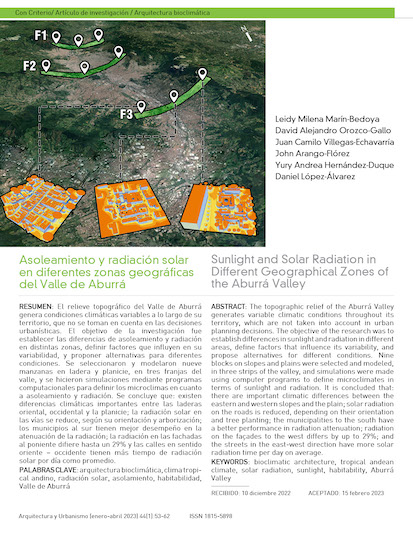Sunlight and Solar Radiation in Different Geographical Zones of the Aburrá Valley
Keywords:
bioclimatic architecture, tropical andean climate, solar radiation, sunlight, habitability, Aburrá ValleyAbstract
The topographic relief of the Aburrá Valley generates variable climatic conditions throughout its territory, which are not taken into account in urban planning decisions. The objective of the research was to establish differences in sunlight and radiation in different areas, define factors that influence its variability, and propose alternatives for different conditions. Nine blocks on slopes and plains were selected and modeled, in three strips of the valley, and simulations were made using computer programs to define microclimates in terms of sunlight and radiation. It is concluded that: there are important climatic differences between the eastern and western slopes and the plain; solar radiation on the roads is reduced, depending on their orientation and tree planting; the municipalities to the south have a better performance in radiation attenuation; radiation on the façades to the west differs by up to 29%; and the streets in the east-west direction have more solar radiation time per day on average.

Downloads
Published
How to Cite
Issue
Section
License
a. The authors retain the copyright and guarantee the magazine the right to be the first publication of the work as well as a Creative Commons Attribution License that allows others to share the work with an acknowledgment of the authorship of the work and the initial publication in this magazine.
b. Authors may separately establish additional agreements for the non-exclusive distribution of the version of the work published in the journal (for example, place it in an institutional repository or publish it in a book), with an acknowledgment of its initial publication in this journal.
c. Authors are allowed and encouraged to disseminate their work electronically (for example, in institutional repositories or on their own website) before and during the submission process, as it can lead to productive exchanges, as well as a more early and major published papers (See The Effect of Open Access, in English).

